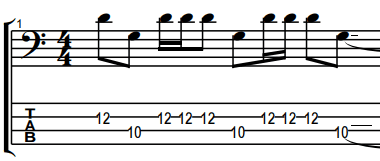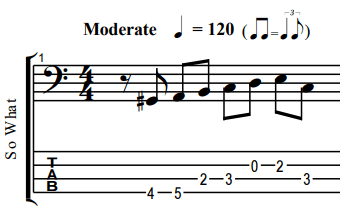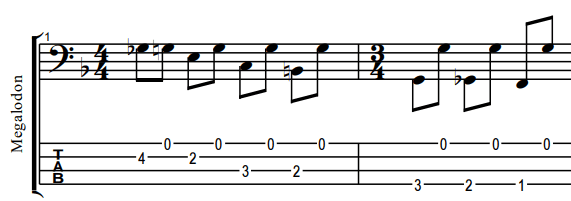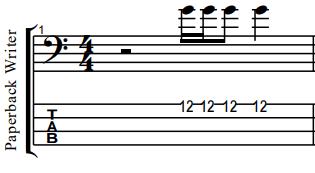As a bass player, there are few things that are more satisfying than stumbling over a great bass lick for the first time.
However, while these short melodic passages sound great, it can be hard to know how to draw inspiration from them. At least, if you want to avoid copying them note for note.
Therefore, I have made this list of 12 great bass licks. More importantly, I`ve specified what you can learn from them to improve your bass playing.
This way you can learn from the greats, without having to steal or modify their bass licks. In turn, you will improve your ability to write unique and creative bass licks.
As an added bonus, I`ve kept the list versatile, so chances are you will also find some great licks you haven`t heard before. Let`s get to it.
If you are more interested in reading about full bass lines rather than bass licks, check out this article on underrated basslines instead.
12. Stone Temple Pilots – Big Empty
- Lick occurs at: 3:15
- Bass Player: Robert DeLeo
- Genre: Rock
The bass lick in the bridge of “Big Empty” leads into a heavy riff. This is expected from a rock song. However, the lick is unique in that it does so without the rest of the band joining in when the heavy riff starts.
Thus, what we can learn from this is that bass licks don`t always have to lead to a chorus, heavy riff, or a crescendo. Sometimes, they can simply fill the void in a song, without being a signal that the song is about to pick up speed.

It is not uncommon for slow bridges of this kind to have some licks in them. However, they are usually played by guitarists, and rarley by bassists.
Thus, for songs with lots of empty space or prolonged ambient parts, try throwing in a bass lick. Oftentimes, the bass can do this just as well as a guitar, if not even better.
11. Jamiroquai – Too Young To Die
- Lick occurs at: 0:28
- Bass Player: Stuart Zender
- Genre: Funk
This Stuart Zender lick threads a fine line between lick and main groove. For this exact reason, I decided to include it on the list, as there is a valuable lesson in it.
It`s a funky groove that mainly consists of ascending and descending a power chord. There are a lot of staccato notes, mutes, and rests, that together make this lick sound incredibly funky.

What makes “Too Young To Die” special, is that this bass lick is an extension of the bass groove. It retains its core rhythm and harmony, but adds to both to make it a more noticeable transition into the verse.
This way, the bass avoids breaking the feeling of the main groove, while playing a bass lick at the same time. The lesson in this is that sometimes licks work best when they don`t deviate from the main bassline, but rather build upon it instead.
10. CeeLo Green – Forget You
- Lick occurs at: 2:47
- Bass Player: Pino Palladino
- Genre: R&B
Pino Palladino`s bassline on “Forget You” is smooth through and through.
Its highlight though comes towards the end of the bridge, where he plays an ascending bass lick.
There are two noteworthy things about this one. First off, it not only ascends melodically, but it does so while playing octaves. As a result, the bassline makes both small and big leaps up in pitch at the same time. This, in turn, creates an immense sense of build-up while still sounding funky.

The other noteworthy thing about this lick is that it does not lead directly into the next part of the song. Rather, we get 1 more bar of the bridge, which the bass fills with a deep sustained note followed by a slide. This works incredibly well, as this lets the drums and vocals ramp up the last bar instead.
Because of this, the song essentially ramps up twice, which was only made possible by the bass lick being played earlier than expected. Thus, playing bass licks a bar or two earlier than normal is an unexpected but effective way to add build-up to a song.
9. Bombay Bicycle Club – How Can You Swallow So Much Sleep
- Lick occurs at: 1:38
- Bass Player: Ed Nash
- Genre: Indie Rock
The bass lick on “How Can You Swallow So Much Sleep” does several things incredibly well.
First off, it showcases how much can be achieved with just two notes and a perfect fifth interval. Combine this with a fast and unpredictable rhythm, and you get a simple melody that still manages to sound groovy.

What`s also worth noting is that during this part, the drums, guitar, and vocals do not increase in intensity whatsoever. Thus, the bass is the only instrument that clearly signals that the current part is about to end.
However, when a bass lick is as prevalent and intense as this, it can be enough to create a noticeable crescendo. Thus, if a part of a song needs to end on a high note, a bass lick can often achieve this on its own.
8. Miles Davis – So What
- Lick occurs at: 0:33 (Kind Of Blue Legacy Edition)
- Bass Player: Paul Chambers
- Genre: Jazz
“So What” has one of the most legendary jazz motifs of all time. It`s played in D an Eb Dorian, which is a common jazz bass scale.
The main bass lick consists of an 8th-note swing rhythm. It has a two-fold purpose, as it both ramps into the main theme of the song and works as an integral part of it.

It is the fact that Paul Chambers continues playing this lick during the main theme that makes it so effective.
This way the same melody works both as a solo lick and as part of the main bass line. As a result, the lick not only works great on its own but sounds cohesive with the song as a whole.
7. Rancid – Fall Back Down
- Lick occurs at: 2:30
- Bass Player: Matt Freeman
- Genre: Punk
Matt Freeman is one of the best punk bass players of all time due to his skill and versatility.
“Fall Back Down” is a great example of him using pairs of notes to add melody to a song while retaining the drive of the bass line. In particular, he plays a quick bass lick towards the end of the bridge that makes use of this pattern:

These types of licks are common in punk, but can also be applied to any genre.
Playing a lick that only consists of 8th notes will not slow the song down. Therefore, they are also great for connecting two fast or intense parts of a song, without breaking the momentum.
6. Mastodon – Megalodon
- Lick occurs at: 0:43
- Bass Player: Troy Sanders
- Genre: Sludge Metal
Bass licks are not as common in metal as in other genres. This is because without the bass holding down the low-end, a band can quickly lose its heaviness.
However, on “Megalodon” Troy Sanders shows how well metal bass licks can work when they are done right. It`s an unconventional one, as instead of holding down a low groove while playing high melodies, he does the opposite:

This creates an effect, where despite the bassline descending, it also sounds like it is playing the same melody throughout it. The result is a mindbending lick, that leads well into the following riff.
Thus, playing a lick with a repeated melodic note and a descending bass line is a unique and effective way to connect pieces of a song. This can work well in genres outside of metal, especially so if you avoid descending chromatically.
Note: This song is played in D Standard, so make sure to tune down your bass if you want to give the song a try.
5. The Beatles – Paperback Writer
- Lick occurs at: 0:11
- Bass Player: Paul McCartney
- Genre: Rock
Don`t let the simplicity of McCartney`s short lick on “Paperback Writer” make you underestimate its effectiveness.
At its core, the lick is just a G note repeated 4 times. There are however 2 notable things about it. One, it`s played high up on the fretboard. Two, it starts fast and then slows down in speed.

Thus, the rhythm of this lick makes the song sound like it`s winding up. This is particularly useful when transitioning from an intro to an upbeat verse like McCartney does here. It is also an effective lick to play when a song has slowed down and is about to pick up speed again.
By playing a high G3, the bass is clearly audible in the mix. Playing high licks of this kind works best when the bass has not been playing anything prior to it. This way, the lick won`t make the song suddenly sound hollow due to the lack of low end, but rather makes deep bass lines that proceed it more impactful.
4. Streetlight Manifesto – Walking Away
- Lick occurs at: 0:09
- Bass Player: Josh Ansley
- Genre: Ska-Punk
“Walking Away” starts off with a groovy bass solo played by John Ansley. The 4 last bars of it though, make up such a cool bass lick that I had to include it on this list.
What makes it so interesting is how the individual bars are vastly different, yet sound completely cohesive.
Not only that, but despite sounding like it is all over the place, Ansley wraps up the lick well with 4 descending quarter notes. Then, as the brass section starts playing the same melody he just did, it makes the bass lick feel like the perfect intro for the song.

The lesson in this lick is that you can combine different melodies and rhythms into the same lick, as long as you tie them together well. Notice how the beginning of the 2nd, 3rd, and 4th bars could all work as a fitting end to the bars that preceded them:
- First to the second bar: A 16th note tonic followed by a dotted quarter note perfect fifth.
- Second to the third bar: A quarter note tonic followed by a quarter note perfect fourth.
- Third to the fourth bar: A quarter note perfect fourth followed by a quarter note perfect fifth.
These sustained notes create a good bit of breathing room. Also, the intervals all consist of core notes of the scale.
Therefore, there is room for the lick to get experimental between them. This shows us that you can do a lot of different things within a lick, as long as you tie its individual parts together well.
3. Pete Townshend – Give Blood
- Lick occurs at: 1:08
- Bass Player: Pino Palladino
- Genre: Rock
For another great Pino Palladino lick, listen to “Give Blood” by Pete Townshend.
Prior to the bass lick, the song has been building up for a minute. The bass has played 6 bars of sustained notes, and it`s finally time for the song to kick into high gear.
Pino achieves this by playing a fast 2-part lick. Just like on “So What”, the lick is then played as part of the verse groove.

The 2 fast parts of the lick are separated by 1 long sustained note. In the first part, the bass lick first makes it clear that we are about to transition into a new part of the song with a fast ascending melody. With the second, it makes the actual transition by descending into the verse groove.
This creates a lot of suspense and makes the fill more interesting than if it just consisted of 16th notes.
When writing bass licks it can feel like you need to cram as much melody as you can into a couple of bars. However, this lick shows us that a well-placed long note can be just as, if not even more effective.
2. Wheater Report – Teen Town
- Lick occurs at: 0:09
- Bass Player: Jaco Pastorius
- Genre: Fusion Jazz
Listening to Jaco Pastorius play his bass of doom is one of the best ways to find inspiration for writing bass licks.
In fact, this entire list could have been made up of licks from “Teen Town”, as the bass is a very dominant instrument on this track. One of the most notable licks on the track is the very first 2 bars of the bassline.

One of the key ways Jaco makes this line stand out is by not entering the first note of either bar. Instead, he rests for a 16th note before the starts playing. This gives the lick a free-form and solo-like feel.
Thus, for bass licks that are meant to be the center of attention, it can often be a good idea to think outside the box when it comes to rhythm. When done right, this will make your bass licks stand out and enable you to rival the best jazz bass lines of all time.
1. Rush – YYZ
- Lick occurs at: 2:10
- Bass Player: Geddy Lee
- Genre: Progressive Rock
“YYZ” is an instrumental song where the members of Rush showcase why they are regarded as some of the best at their individual instruments.
While Geddy Lee`s bassline is impressive throughout the whole track, he most notably plays 3 solo licks during the middle parts of the song. One of these consists of an accending lick, and a beautiful pair of harmonic chords.

While it`s easy to get intimidated by the difficulty of this lick, there is a lot to learn from it for bassists of all skill levels. Namely, it showcases how a slide down towards the end of a lick can make even the most complicated of licks fit within a song.
It also shows how ascending melodically is a great way to start off a solo bass lick. This is because despite being vastly different from the preceding part of the song, it still feels natural and fitting.
Thus, while emulating Lee`s speed is difficult, applying the same idea is useful if you are looking to write a bass solo or a song calls for a short solo bass lick.

